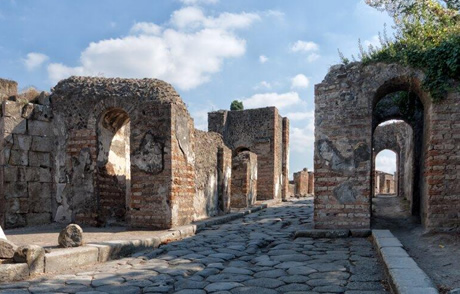Necropolis of Porta Ercolano
Location
City/Town
Pompeii
Modern Country
Italy
Culture
Roman
Site Type
Necropolis

Description
This necropolis is situated at the Porta Ercolano gate near the VI region of Pompeii. This is the largest necropolis discovered in Pompeii. It contains tombs, urns, and burials. The larger tombs house cremated bodies placed in urns. Many burials were marked with a human bust which was common way to mark resting places. Among the most common types of tombs were those with an aedicula, exedra, and those surrounded by a wall or fence. On the less common side there are some tombs that are designed to look like temple altars by being made in marble and built on a podium with statues on the sides.

Notable Tombs
Tomb of C. Calventius Quietus and C. Munatius Faustus
The inscription reads:
“To Ciaus Calventius Quietus, Augustalis. On account of his munificence he is honored with a bisellium by decree of the decurion and with the consensus of the people.”
On the other face is a carving of a ship which represents his commercial pursuits and the voyage of life.

Tomb of Priestess Mamia
This tomb was dedicated to the Priestess Mamia and it was created to be a semi-circular bench with an inscription written across it.
Inscription:
MAMIAE P F SACERDOTI PVBLICAE LOCVS SEPVLITVR DATVS DECVRIONVM DECRETO’
Translated:
‘To Mamia daughter of Publius Mamius, City Priestess. Gravesite given by decree of the town council.’

Tomb of the Libella
This tomb is built of blocks of travertine and resembles a pedestal of a column. It has a long inscription that states that this site was given by the public, by Alleia Decimilla, a public priestess of Ceres, to her husband and son, Marcus Alleius Lucius Libells the father, aedile, duumvir, and quinquennial praefect, and M. Alleius Libella the son, decurion, who lived 17 years.


Key Words
Aedicula
Bisellium
Exedra
Tomb
Necropolis